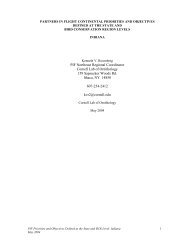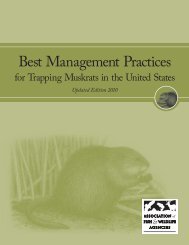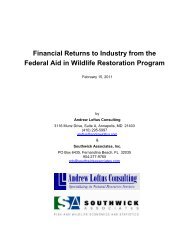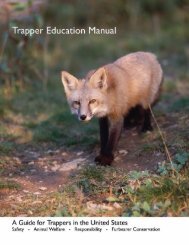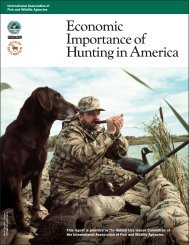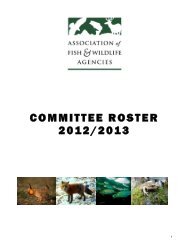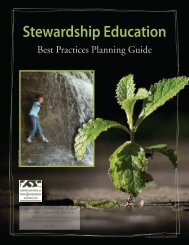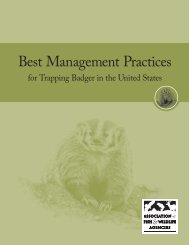Modern Snares for Capturing Mammals: - Association of Fish and ...
Modern Snares for Capturing Mammals: - Association of Fish and ...
Modern Snares for Capturing Mammals: - Association of Fish and ...
- No tags were found...
Create successful ePaper yourself
Turn your PDF publications into a flip-book with our unique Google optimized e-Paper software.
more rapidly once an animal’s movement initiates loop closure. Snare loading, <strong>of</strong>tendone to improve capture efficiency, may NOT be wise in situations where there is adesire to allow smaller animals, which may still bump the snare, to pass through a snareset <strong>for</strong> another species (e.g., to allow an otter to pass through a beaver snare). Thesensitivity to loop closure <strong>for</strong> passively-activated snares can also be influenced by theposition the lock is placed on the loop during deployment (e.g., “11 o’clock”, “12o’clock”, or “2-o’clock”). Reducing sensitivity may prevent a loop from closing if asmaller animal to be avoided goes through <strong>and</strong> bumps the snare.‣ Breakaway devices – Breakaway devices can be designed in many ways, <strong>and</strong> numerousexamples were illustrated previously. Basically, they allow the snare loop to break open<strong>and</strong> an animal to escape completely free <strong>of</strong> the snare when a specified amount <strong>of</strong> <strong>for</strong>ce isapplied. Hence, they are used to prevent restraint <strong>of</strong> animals capable <strong>of</strong> generating more<strong>for</strong>ce than the animal <strong>of</strong> interest.As with killing potential, there are multiple snare component configurations or setting methodsthat may be used to accomplish a particular selectivity objective. We illustrate this point with anissue that has arisen in some states. “Deer stops”, <strong>of</strong>ten recommended to minimize capture <strong>of</strong>deer by the leg, make it impractical to use snares to capture smaller furbearers like mink ormuskrats. Alternative options that may be just as effective at reducing deer capture, withouteffectively prohibiting mink or muskrat capture, include the use <strong>of</strong> breakaway devices or use <strong>of</strong> amaximum loop stop that mechanically prevents loops that are large enough to have a realisticprobability <strong>of</strong> capturing a deer. Whether there is a need <strong>for</strong> any special selectivity features, <strong>and</strong>the appropriate configuration if so, may vary depending on location, species present, otherper<strong>for</strong>mance needs (e.g., killing potential, efficiency), <strong>and</strong> user preference.Snare EfficiencyAs with selectivity, efficiency can be defined or computed in different ways. Similar to thedefinition utilized in the development <strong>of</strong> Best Management Practices <strong>for</strong> trapping, we defineefficiency as the proportion <strong>of</strong> times the device captures <strong>and</strong> holds the intended animal that hasactivated the device. This is distinct from ‘captures/trap night’, a measure that is highlyinfluenced by variations in animal population density. Because many snares are passivelyactivated,activation in this context means the snare has been altered by the animal from its setposition. As with all capture devices, the manner in which a snare is deployed can greatlyinfluence efficiency. In contrast to selectivity, we felt the influence <strong>of</strong> some user-controlledvariables (e.g., loop size, loop height, etc) on snare efficiency is more appropriately left <strong>for</strong>specific snaring “How To” books. We acknowledge the importance <strong>of</strong> those factors, but focusmore on the role that various mechanical features may play in efficiency. Again, comparativestatements are based on the assumption that “all other variables are equal”.‣ Cable diameter – cable diameter can influence efficiency in two ways: 1) when an animalis live-restrained, by intent or otherwise, smaller-diameter cables have reduced breakingstrengths, <strong>and</strong> may be more prone to breaking if excessive <strong>for</strong>ce is applied or if the liveanimal chews on the cable; 2) while animal sensory capabilities vary by species, some21Ver. 1.0



